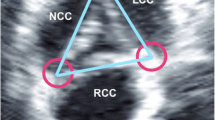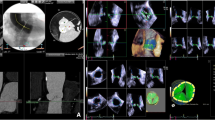Abstract
In computed tomography (CT) evaluation prior to transcatheter aortic valve implantation area- and perimeter-based calculation of the aortic annulus diameter, the so-called effective annulus diameter (ED), is the preferred parameter for decision making regarding prosthesis sizes. Currently, it is unclear how relevant the differences between the two methods of measurement are and how they are influenced by the cardiac cycle. The aim of this study was to compare area- and perimeter-based measurements in computed tomography derived aortic annulus sizing. A total of 60 patients who underwent evaluation for transcatheter aortic valve implantation were included in this study. All patients received pre-procedural ECG gated CT. The aortic annulus area and perimeter were measured and the derived ED compared using parametric statistics and Bland and Altman analysis. The mean patient age was 80.2 ± 4 years. Systolic aortic annulus area and perimeter were higher compared to diastolic results (mean difference area 12.8 ± 24 mm2 and perimeter 0.72 ± 1 mm; p = 0.009–0.068). Both the area- and perimeter-based ED had a good agreement within two standard deviations for systolic and diastolic measurements. Effective diameter measurements derived from the area were significantly smaller compared to perimeter-based measurements (mean difference: systolic 0.72 ± 0.3 mm and diastolic 0.81 ± 0.4 mm; p < 0.001). While the area-based ED was significantly influenced by the cardiac cycle with a mean difference of 0.4 ± 0.6 mm (p = 0.009), no significant difference was found for the perimeter-based ED (mean difference: 0.2 ± 0.4; p = 0.07). For patients undergoing CT evaluation prior to transcatheter aortic valve implantation, the perimeter-based effective annulus diameter provides a reliable parameter for annulus sizing without significant affection by the cardiac cycle and therefore facilitates annulus measurements with a single heart phase. However, perimeter-based diameters of the annulus are significantly larger than area-based diameters.




Similar content being viewed by others
References
Holmes DR Jr, Mack MJ, Kaul S, Agnihotri A, Alexander KP, Bailey SR et al (2012) American Heart A, American Society of E, European Association for Cardio-Thoracic S, Heart Failure Society of A, Mended H, Society of Cardiovascular A, Society of Cardiovascular Computed T, Society for Cardiovascular Magnetic R. 2012 ACCF/AATS/SCAI/STS expert consensus document on transcatheter aortic valve replacement: developed in collabration with the American Heart Association, American Society of Echocardiography, European Association for Cardio-Thoracic Surgery, Heart Failure Society of America, Mended Hearts, Society of Cardiovascular Anesthesiologists, Society of Cardiovascular Computed Tomography, and Society for Cardiovascular Magnetic Resonance. J Thorac Cardiovasc Surg 144:e29–e84
Leon MB, Smith CR, Mack M, Miller DC, Moses JW, Svensson LG et al (2010) Transcatheter aortic-valve implantation for aortic stenosis in patients who cannot undergo surgery. N Engl J Med 363:1597–1607
Achenbach S, Delgado V, Hausleiter J, Schoenhagen P, Min JK, Leipsic JA (2012) SCCT expert consensus document on computed tomography imaging before transcatheter aortic valve implantation (TAVI)/transcatheter aortic valve replacement (TAVR). J Cardiovasc Comput Tomogr 6:366–380
Lehmkuhl L, Foldyna B, Haensig M, von Aspern K, Lucke C, Andres C et al (2013) Role of preprocedural computed tomography in transcatheter aortic valve implantation. Rofo 185:66–67
Lehmkuhl LH, von Aspern K, Foldyna B, Grothoff M, Nitzsche S, Kempfert J et al (2013) Comparison of aortic root measurements in patients undergoing transapical aortic valve implantation (TA-AVI) using three-dimensional rotational angiography (3D-RA) and multislice computed tomography (MSCT): differences and variability. Int J Cardiovasc Imaging 29:417–424
Dill KE, George E, Abbara S, Cummings K, Francois CJ, Gerhard-Herman MD et al (2013) ACR appropriateness criteria imaging for transcatheter aortic valve replacement. J Am Coll Radiol 10:957–965
Cerillo AG, Mariani M, Berti S, Glauber M (2012) Sizing the aortic annulus. Ann Cardiothorac Surg 1:245–256
Gurvitch R, Webb JG, Yuan R, Johnson M, Hague C, Willson AB et al (2011) Aortic annulus diameter determination by multidetector computed tomography: reproducibility, applicability, and implications for transcatheter aortic valve implantation. JACC Cardiovasc Interv 4:1235–1245
Kempfert J, Van Linden A, Lehmkuhl L, Rastan AJ, Holzhey D, Blumenstein J et al (2012) Aortic annulus sizing: echocardiographic versus computed tomography derived measurements in comparison with direct surgical sizing. Eur J Cardiothorac Surg 42:627–633
Lehmkuhl L, Foldyna B, von Aspern K, Lucke C, Grothoff M, Nitzsche S et al (2013) Inter-individual variance and cardiac cycle dependency of aortic root dimensions and shape as assessed by ECG-gated multi-slice computed tomography in patients with severe aortic stenosis prior to transcatheter aortic valve implantation: is it crucial for correct sizing? Int J Cardiovasc Imaging 29:693–703
Van Linden A, Kempfert J, Blumenstein J, Mollmann H, Kim WK, Alkaya S et al (2014) Manual versus automatic detection of aortic annulus plane in a computed tomography scan for transcatheter aortic valve implantation screening. Eur J Cardiothorac Surg 46:207–212
de Heer LM, Budde RP, Mali WP, de Vos AM, van Herwerden LA, Kluin J (2011) Aortic root dimension changes during systole and diastole: evaluation with ECG-gated multidetector row computed tomography. Int J Cardiovasc Imaging 27:1195–1204
Anderson RH (2000) Clinical anatomy of the aortic root. Heart 84:670–673
Bland JM, Altman DG (1999) Measuring agreement in method comparison studies. Stat Methods Med Res 8:135–160
Cribier A, Eltchaninoff H, Bash A, Borenstein N, Tron C, Bauer F et al (2002) Percutaneous transcatheter implantation of an aortic valve prosthesis for calcific aortic stenosis: first human case description. Circulation 106:3006–3008
Watanabe Y, Morice MC, Bouvier E, Leong T, Hayashida K, Lefevre T et al (2013) Automated 3-dimensional aortic annular assessment by multidetector computed tomography in transcatheter aortic valve implantation. JACC Cardiovasc Interv 4:1235–1245
Schultz C, Moelker A, Tzikas A, Piazza N, de Feyter P, van Geuns RJ et al (2010) The use of MSCT for the evaluation of the aortic root before transcutaneous aortic valve implantation: the Rotterdam approach. EuroIntervention 6:505–511
Pershad A, Stone D, Morris MF, Fang K, Gellert G (2013) Aortic annulus measurement and relevance to successful transcatheter aortic valve replacement: a new technique using 3D TEE. J Interv Cardiol 26:302–309
Hamdan A, Guetta V, Konen E, Goitein O, Segev A, Raanani E et al (2012) Deformation dynamics and mechanical properties of the aortic annulus by 4-dimensional computed tomography: insights into the functional anatomy of the aortic valve complex and implications for transcatheter aortic valve therapy. J Am Coll Cardiol 59:119–127
Blanke P, Siepe M, Reinohl J, Zehender M, Beyersdorf F, Schlensak C et al (2010) Assessment of aortic annulus dimensions for Edwards SAPIEN Transapical Heart Valve implantation by computed tomography: calculating average diameter using a virtual ring method. Eur J Cardiothorac Surg 38:750–758
Conflict of interest
None.
Author information
Authors and Affiliations
Corresponding author
Additional information
K. von Aspern and B. Foldyna contributed equally to this study.
Rights and permissions
About this article
Cite this article
von Aspern, K., Foldyna, B., Etz, C.D. et al. Effective diameter of the aortic annulus prior to transcatheter aortic valve implantation: influence of area-based versus perimeter-based calculation. Int J Cardiovasc Imaging 31, 163–169 (2015). https://doi.org/10.1007/s10554-014-0527-4
Received:
Accepted:
Published:
Issue Date:
DOI: https://doi.org/10.1007/s10554-014-0527-4




